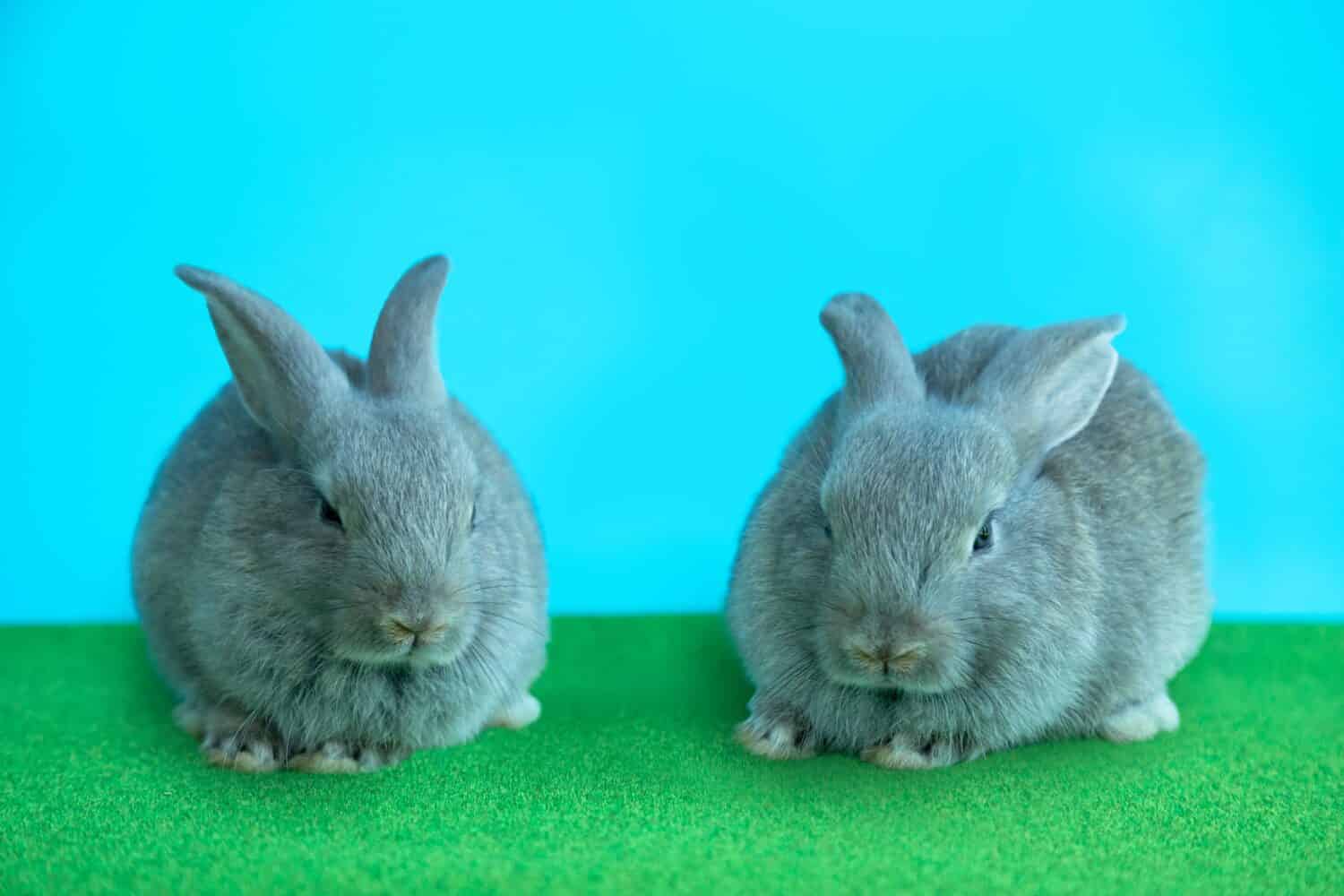Whether you’re looking to get your first rabbit, want to add an additional bunny to your menagerie, or are curious about the wild bunnies in your yard, understanding the differences between male and female rabbits can be very important.
Knowing the differences between males (bucks) and females (does) can help you determine the best choice for your household pet, or assist you in properly naming the wild bunnies that are eating your garden. It can also ensure you don’t accidentally house unaltered males and females together in your home. If you do that, you may have more bunnies than you can count before you know it!
In addition to the different roles that they play in making little bunnies, there are several differences between males and females in domestic breeds and wild species. These differences include variations in size, anatomy, behavior, and roles.
1. Rabbit Appearance and Anatomy

Dewlaps are fat deposits on the neck and that are common in females in some breeds. Then often give the rabbit the appearance of having a double chin.
Unlike other animals, rabbits don’t exhibit sexual dimorphism. This means that there aren’t really any differences in size or appearance between bucks (male rabbits) and does (female rabbits). In wild rabbits, females tend to be heavier, but weight ranges between sexes overlap dramatically.
While rabbits are generally sexually monomorphic, there are slight physical differences in several domestic breeds. Some female domestic large breeds, such as Flemish giants, and lop-eared rabbit breeds have dewlaps. A dewlap is a pouch of fat beneath the jaw of the rabbit, which can make it look like the rabbit has a double chin. These are commonly seen in female rabbits that were not spayed before they reached sexual maturity. As an un-spayed female ages, her dewlap may continue to grow. When a female is pregnant, she will pull fur from her dewlap to build a nest.
Male rabbits do not participate in nest building, so have no need for a dewlap. Genetically speaking, all rabbits can form a dewlap, but it is rare in males. In the cases where males do develop dewlaps, it is generally the result of the rabbit gaining weight. Fatty tissues build up around the rabbit’s neck and chin as it puts on weight, expanding the skin into a dewlap pouch similar to that in females. The presence of a dewlap is not a definitive way to sex a rabbit, since it’s impossible to say by visual examination whether a dewlap is caused by weight gain.
Male vs. Female Rabbit Anatomy
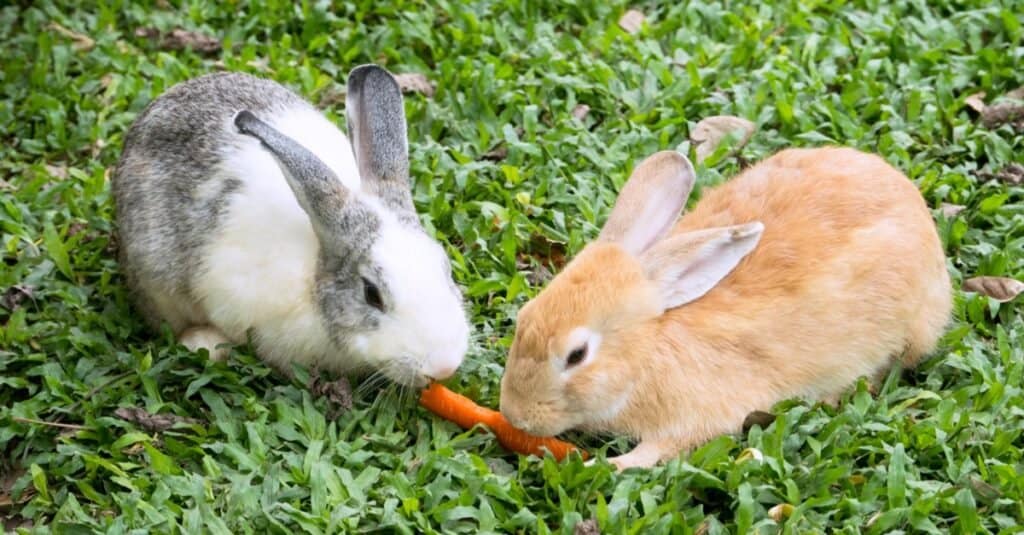
A common myth is that carrots make up most of a rabbit’s diet. In reality, carrots are high in sugar and should only be given occasionally.
©Thor Jorgen Udvang/Shutterstock.com
The most conclusive way to determine if a rabbit is male or female is to check their genitalia. Female rabbits have V-shaped genitalia that protrudes slightly and is immediately above the anus. Males have oblong testicles that sit separate from the anus. In domestic breeds, the testicles will drop when the male is around 12 weeks old. Males younger than 12 weeks won’t have visible testes, while neutered males won’t have them at all.
Female rabbits have what is called a bicornuate duplex uterus. Her uterus has two separate uterine horns, and each has its own cervix. Because of this, rabbits have the ability to carry two pregnancies simultaneously. However, double pregnancies can be dangerous to both the babies (called kits) and the doe. This makes it especially important to ensure domestic does that haven’t been spayed are closely monitored when living with bucks.
2. Bunny Behavior
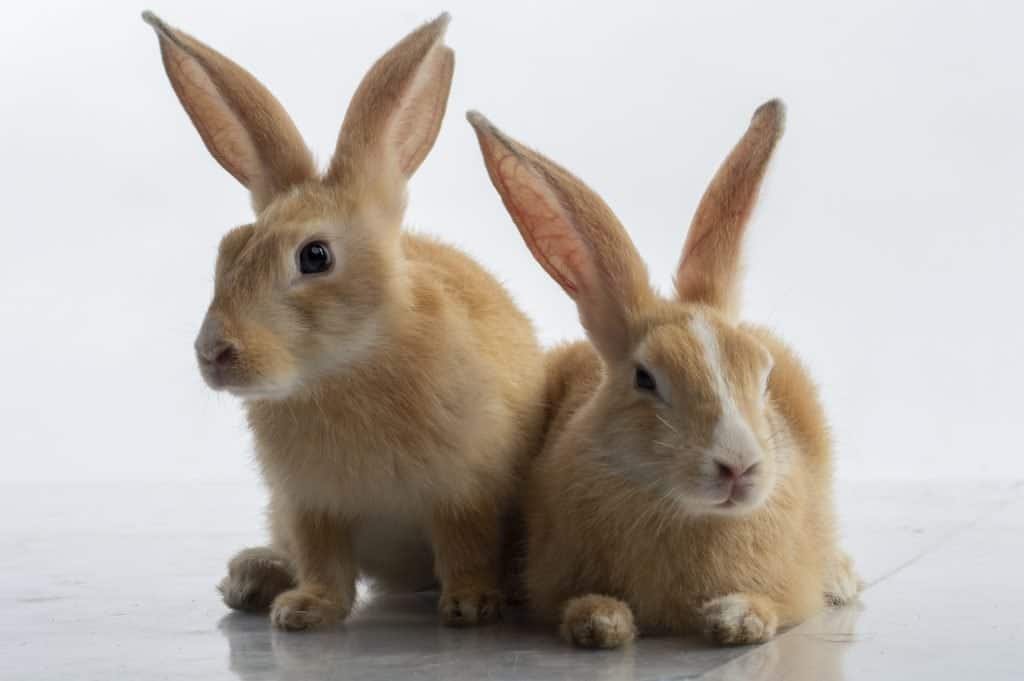
While the largest rabbit on record was over 4 feet long, the smallest breeds measure around nine inches in length.
The male is more aggressive in many species, but not in rabbits. Female rabbits tend to be more territorial and dominant than males. From an evolutionary standpoint, this makes sense. Females need to protect their nests and babies from predators. This instinct is found even in domestic rabbits.
In comparison, male rabbits are more laid back and less territorial. Domestic bucks also generally bond more quickly with people than females. Female rabbits are less extroverted than males, and can be more cautious.
That isn’t to say that bucks don’t care about territory. Unneutered domestic males will mark their territory by spraying urine, and they will be protective or aggressive to other males if a female rabbit is around. While does are quicker to react aggressively, males use much more force when they do. Neutered males exhibit territorial behavior less often, so neutering male rabbits is a good way to prevent spraying and aggression.
Due to their more territorial nature, does will usually urinate and defecate in one place, while bucks tend to spread it around. This means female domestic rabbits are often easier to litter train than males. Wild female rabbits will urinate and defecate away from their nests to avoid attracting predators to her kits.
Wild rabbits also show behavioral differences in their territory ranges. Male and female eastern cottontails have different territory ranges. The average home range for adult males is 1.4 acres. However, male ranges in some areas have been reported to be as large as 10 acres in early summer, when they are looking to breed. Female rabbits usually have a smaller average range of 1.2 acres.
3. Rabbit Roles
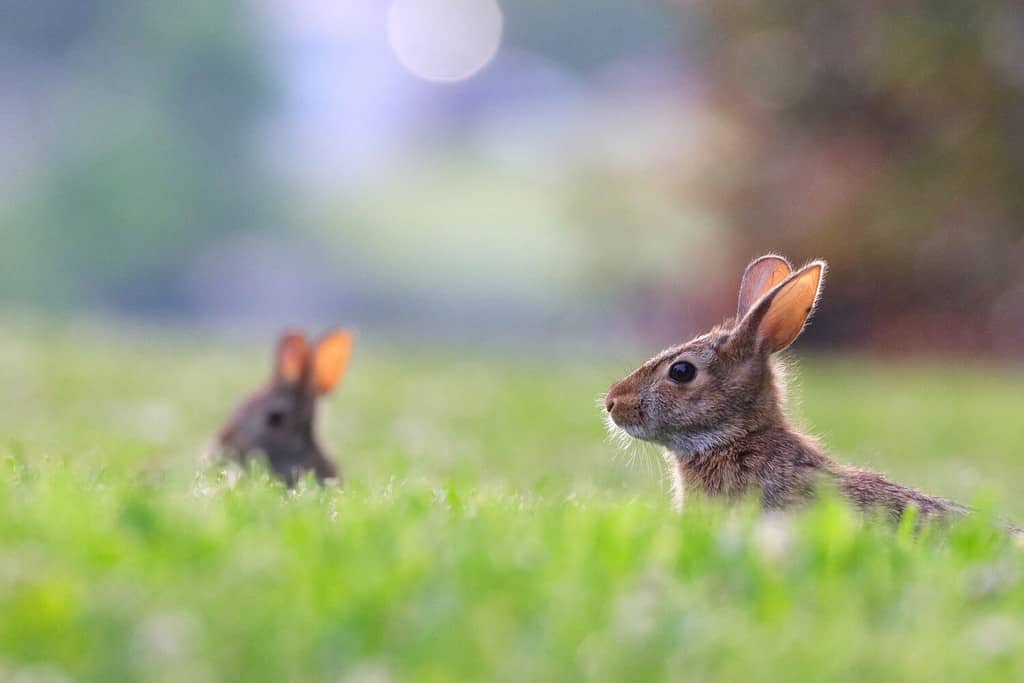
Eastern cottontails can have up to 70 babies per year, usually between the months of March and September.
©Wirestock Creators/Shutterstock.com
Domestic rabbits reach sexual maturity at different ages, depending on the breed. For example, small breeds can breed at four to five months old, while larger breeds, such as the Flemish giant, shouldn’t be bred before seven months. Females of all breeds usually reach sexual maturity before males. Males impregnate the females, but do not aid in the raising of the kits.
The dynamics are similar between domestic and wild bunnies. While solitary, wild eastern cottontails have a social hierarchy. The dominant males do the bulk of the breeding. Does go into their first heat in late February, and can continue breeding through the fall.
And cottontails are prolific breeders. Female cottontails can produce litters of up to 10 kits every 30 days. They generally have three pregnancies per year, but they can have up to five.
Rabbit Motherhood

Eastern cottontail kits don’t open their eyes until they are seven days old.
©Jerry Morse/Shutterstock.com
Female rabbits care for the kits on their own, with no help from the males. Much like domestic rabbits, cottontails make nests lined with dried grass and fur from the mother’s body. Cottontails do not dig burrows, but instead excavate shallow depressions in the ground to make their nests.
Once the kits are born, the mother will come to the nest twice a day (usually at dusk and dawn) to feed and groom her babies. She otherwise avoids the nest to avoid drawing predators to the location. Domestic rabbits retain many of these wild instincts, and even mothers in captivity will rarely enter their nesting box to check on the kits during the day.
While domestic kits wean between four and nine weeks of age (depending on the breed,) cottontail kits wean between 16 and 21 days, and leave the nest at around three weeks of age. The mother mates again soon after she has her litter, and is often near delivery again by the time her first litter leaves the nest.
In contrast to domestic breeds, male cottontails reach sexual maturity before females. Males can be sexually mature as young as one month old, though most reach maturity around two to three months. Females are sexually mature at around three months, but often do not breed until the next year. However, juvenile rabbits produce 25% of litters each year, so not all abstain until the following season.
Male vs. Female Rabbits: The Bottom Line
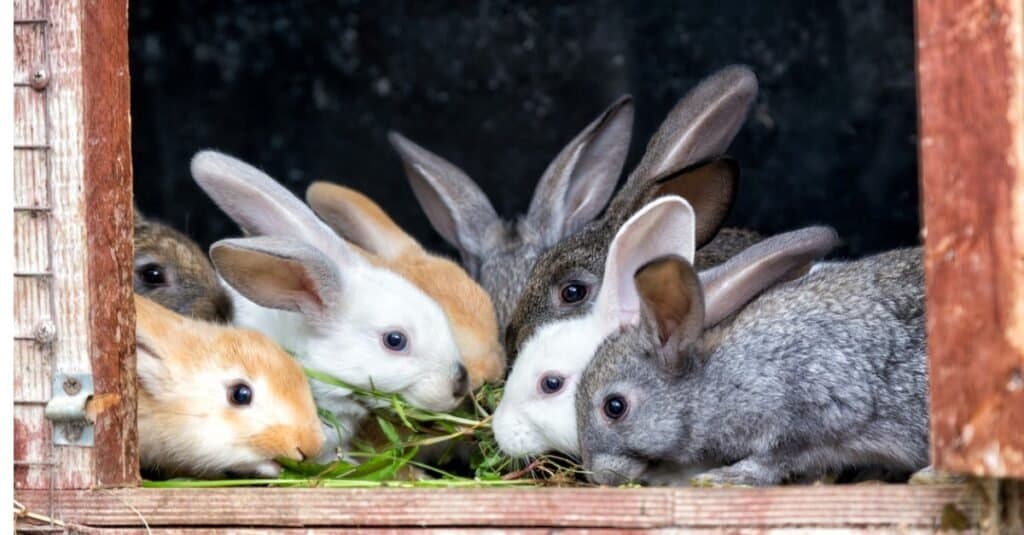
A group of rabbits can be known as a fluffle, colony, or herd.
©iStock.com/Laures
Ultimately, both male and female rabbits have their strengths. While males may be more friendly and outgoing, females are tenacious mothers dedicated to protecting their offspring. Males are harder to litter train and have a tendency to spray, but females are less likely to engage with people. When it comes to wild rabbits, males adventure farther and have bigger territories, while females stay close to home to care for their young.
Regardless of the sex, rabbits have delightful behaviors and quirks that make them both excellent pets and wild neighbors.
Thank you for reading! Have some feedback for us? Contact the AZ Animals editorial team.

